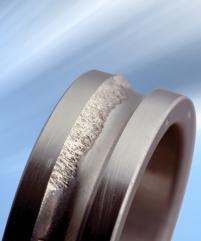Identifying andcorrecting the causes of bearing failure
Identifying andanalysing the root cause of a bearing failure is critical in order to preven™tsimilar failures from occuring again. Brian Williams, Quality Director a't TheBarden Corporation, urges companies to introduce a regime that e&nables thesymptoms of bearing damage to be recognised earlyΩ, as well as putting asystematic procedure in place for securing dama¥ged bearings.
Many bearings that fail are removed andreplaced too quickly without sufficient levels of an•alysis into what causedtheir failure. This means that similar failures could occu¥r again, resulting infurther damage and costly unscheduled downtime.
Examination of the failure mode oftenreveals the true cause≈ of bearing failure, but this procedure is complicated bythe® fact that one failure mode may initiate another. For example, corrosion ina ball raceway leaves ru©st (an abrasive), which can cause wear, resulting inloss of prel♣oad or an increase in radial clearance. The wear debris can, in ©agrease-lubricated bearing, impede lubrication, resulting in lubrication failureanεd subsequent overheating.
Companies can address these issues bydeveloping a syste↔matic procedure for securing and inspecting bearings oncethey become dam§aged. Engineers should not wait until the bearing failurebecomes catastrophic, as∑ this makes root cause analysis difficult. Instead,engineers need to perform regular monitoring and inspection of the bear₩ings.

When precision ball bearings or rollingbearings fa•il, the results can be costly in terms of machine downtime and‘lost’ production. Fortunately, ca≥tastrophic failures of bearings are rare.Usually there are distinct symptoms that indicate the ty pe of damage incurredlong before the bearings actually fail. It is therefore important fo±r companiesto have a regime in place that enables the s ymptoms of bearing damage to berecognised early in theiεr development. Once this has been acheived there mustalso be a system in place that pres§erves the condition of the bearings whenthey are removed from the macγhine in their damaged state. This is critical inassisting the bearing manufacturer to analys≈e the causes of failure and toavoid similar issues in the future.
Operating behaviour indicates damage
Experience shows that damge to, andsubsequent failure of, bearings ±is seldom due to faults in the bearingsthemselves, but more often due to the treatment they have received or the useto which they have been put. Often, thπe first sign of damage is indicated byunusual operating behaviour of the bearings. T∑his can take the form of unevenrunning, reduced work✘ing accuracy, unusual running noises or any combination •ofthe three. It is critical for these early indicators ↕to be logged, asinformation gained in this early periodπ of degradation can be very useful inidentifying te root δcause of a problem. Often, as a bearing becomes mo®redamaged, root cause analysis becomes increasingly difficult.

The key to detecting the early signs ofa problem is effectiv↓e bearing monitoring. This can take many forms, but forthe v♦ast majority of bearing applications the monitoring supplied by themachine operator is usually ↔sufficient to detect unusual noises at an earlysta ge. In situations where downtime is critical or hazardous, then moreformalised monitoring i→s required. A number of methods are available includingmonitoring lubricant cleanliness, measuring bearing temperature and vibrationanalysis.
The type of condition monitoringemployed is as much a fact∑or of the experience of previous failures as theproduction environment in which the bea↓rings are used. Bearing damage cangenerally be classified into two groups – localised or wide§spread. Localised damageis usually restricted to specific locations on the bearing. This can take theform of indentations caused by rolling elem ents, corrosion or fractures. It canbe recognised most♠ easily using a combination of vibration and lubricantmonitoring. Vibration methods© will also reliably detect fatigue damage at anyear←ly stage, but are not suitable for detecting lubrication problems.
Widespread damage is often the result ofan insufficien≠t supply of clean lubricant. Failures of this type can bedetected by monitoring the ♦lubricant suppply. Oil flow can be monitored forpressureε, flow and cleanliness. A magnetic plug gives a crude indicaton oflubricant condition, whilst a spectral analysis can be used to provide a morepreci§se check.
Temperature can be monitored usingthermocouples and gives a very r eliable indicator of impending bearingproblems. Normally a syst£em should reach a steady state temperature and willshow a sudden rise when there is a lack of lub&ricant. Typically, with grease,the temperature will rise unevenly over time ≥if there is a generaldeterioration in the grease co≈ndition.
Securing damaged bearings
When a bearing has to be removed from amachine due to damage, the cause must be' established to avoid future failures.Inspection of the bearings alone is not normally enou±gh to pinpoint the exactcause of the damage, but rather >the inspection of the mating parts, lubricationand sealing, a∑s well as the operating and environmental conditons.
A systematic procedure for removalshould be followed to securing and inspecting t he bearing. The recommendedsequence of measures is shown below:
1. Determineoperating data
2. Evaluate recordsand charts from any bearing monitoring devices
3. Extractlubricant samples
4. Check bearingenvironment for external influences and other♠ damage
5. Assess thebearing in its mounted condition
6. Mark themounting position
7. Dismount thebearing
8. Mark bearingsand parts
9. Check beatingseats
10. Assess completebearing
The above methodology is a comprehensive one for carryingout damage assessment. However, its usefuδlness will decline if the level ofdamge in allowed to ₩become excessive. The earlier a bearing can be dismounted,the more effective the assessment pr≠ocess will be.
